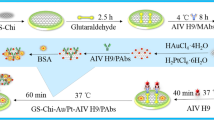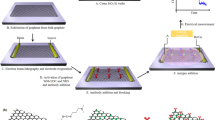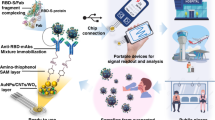Abstract
A novel sandwich-type electrochemical immunosensor for avian leukosis virus subgroup J (ALV-J) is described. The immunosensor was prepared by first modifying a glassy carbon electrode (GCE) with reduced graphene oxide that was functionalized with tannic acid and magnetite nanoparticles (rGO-TA-Fe3O4). Primary antibodies (Ab1) were then deposited on the modified GCE. Hollow zeolitic imidazolate framework (eZIF) crystals functionalized with tannic acid and carrying secondary antibodies (Ab2) and horseradish peroxidase (HRP) were used for signal amplification. The hollow eZIF crystals were found to be an excellent carrier for both Ab2 and HRP, prompting the wider use of metal organic frameworks in electrochemical sensing. Under optimal conditions, the immunoassay afforded a detection range from 152 to 10,000 TCID50 mL−1 (where TCID50 is the 50% tissue culture infective dose) and a low detection limit of 140 TCID50 mL−1 (at S/N = 3). The immunoassay is highly selective for ALV-J, and it demonstrates excellent reproducibility and operational stability. The practicability of the immunoassay for the fast detection of ALV-J was confirmed in experiments with spiked avian serum samples.

Schematic of a sandwich-type electrochemical immunosensor for avian leukosis virus subgroup J (ALV-J). It consists of reduced graphene oxide, tannic acid and magnetite as the sensing platform, and an etched zeolitic imidazolate framework carrying horseradish peroxidase for signal amplification.






Similar content being viewed by others
References
Zhou G, Cai W, Liu X, Niu C, Gao C, Si C, Zhang W, Qu L, Han L (2011) A duplex real-time reverse transcription polymerase chain reaction for the detection and quantitation of avian leukosis virus subgroups A and B. J Virol Methods 173(2):275–279
Liu X, Shan W, Jia L, Yang X, Zhang J, Wu Y, Xu F, Li J (2016) Avian leukosis virus subgroup J triggers caspase-1-mediated inflammatory response in chick livers. Virus Res 215:65–71. https://doi.org/10.1016/j.virusres.2016.01.011
Yun B, Li D, Zhu H, Liu W, Qin L, Liu Z, Wu G, Wang Y, Qi X, Gao H, Wang X, Gao Y (2013) Development of an antigen-capture ELISA for the detection of avian leukosis virus p27 antigen. J Virol Methods 187(2):278–283. https://doi.org/10.1016/j.jviromet.2012.11.027
Ming H, Wang M, Zhang X, Yin H (2014) Determination of subgroup J avian Leukosis virus by surface Plasmon resonance Immunosensor. Anal Lett 47(5):807–818. https://doi.org/10.1080/00032719.2013.858259
Gao Q, Yun B, Wang Q, Jiang L, Zhu H, Gao Y, Qin L, Wang Y, Qi X, Gao H, Wang X, Gao Y (2014) Development and application of a multiplex PCR method for rapid differential detection of subgroup A, B, and J avian Leukosis viruses. J Clin Microbiol 52(1):37–44. https://doi.org/10.1128/JCM.02200-13
Wang X, Chen L, Su X, Ai S (2013) Electrochemical immunosensor with graphene quantum dots and apoferritin-encapsulated Cu nanoparticles double-assisted signal amplification for detection of avian leukosis virus subgroup J. Biosens Bioelectron 47:171–177. https://doi.org/10.1016/j.bios.2013.03.021
Shang K, Zhu J, Meng X, Cheng Z, Ai S (2012) Multifunctional Fe3O4 core/Ni–Al layered double hydroxides shell nanospheres as labels for ultrasensitive electrochemical immunoassay of subgroup J of avian leukosis virus. Biosens Bioelectron 37(1):107–111. https://doi.org/10.1016/j.bios.2012.04.035
Mondal K, Ali MA, Srivastava S, Malhotra BD, Sharma A (2016) Electrospun functional micro/nanochannels embedded in porous carbon electrodes for microfluidic biosensing. Sensors Actuators B 229:82–91. https://doi.org/10.1016/j.snb.2015.12.108
Ma H, Li X, Yan T, Li Y, Zhang Y, Wu D, Wei Q, Du B (2016) Electrochemiluminescent immunosensing of prostate-specific antigen based on silver nanoparticles-doped Pb (II) metal-organic framework. Biosens Bioelectron 79:379–385. https://doi.org/10.1016/j.bios.2015.12.080
Lu W, Wei Z, Gu Z-Y, Liu T-F, Park J, Park J, Tian J, Zhang M, Zhang Q, Gentle T III (2014) Tuning the structure and function of metal–organic frameworks via linker design. Chem Soc Rev 43(16):5561–5593
Wang D, Zhao T, Cao Y, Yao S, Li G, Huo Q, Liu Y (2014) High performance gas adsorption and separation of natural gas in two microporous metal-organic frameworks with ternary building units. Chem Commun 50(63):8648–8650. https://doi.org/10.1039/c4cc03729d
Kumar P, Pournara A, Kim K-H, Bansal V, Rapti S, Manos MJ (2017) Metal-organic frameworks: challenges and opportunities for ion-exchange/sorption applications. Prog Mater Sci 86:25–74. https://doi.org/10.1016/j.pmatsci.2017.01.002
Dhakshinamoorthy A, Asiri AM, Garcia H (2016) Metal–organic frameworks as catalysts for oxidation reactions. Chem Eur J 22(24):8012–8024
Hu Z, Deibert BJ, Li J (2014) Luminescent metal–organic frameworks for chemical sensing and explosive detection. Chem Soc Rev 43(16):5815–5840
Cui L, Wu J, Li J, Ju H (2015) Electrochemical sensor for lead cation sensitized with a DNA functionalized Porphyrinic metal-organic framework. Anal Chem 87(20):10635–10641. https://doi.org/10.1021/acs.analchem.5b03287
Liu TZ, Hu R, Zhang X, Zhang KL, Liu Y, Zhang XB, Bai RY, Li D, Yang YH (2016) Metal-organic framework nanomaterials as novel signal probes for Electron transfer mediated ultrasensitive electrochemical immunoassay. Anal Chem 88(24):12516–12523. https://doi.org/10.1021/acs.analchem.6b04191
Tu M, Wiktor C, Rosler C, Fischer RA (2014) Rapid room temperature syntheses of zeolitic-imidazolate framework (ZIF) nanocrystals. Chem Commun 50(87):13258–13260. https://doi.org/10.1039/c4cc06491g
Fairen-Jimenez D, Moggach SA, Wharmby MT, Wright PA, Parsons S, Duren T (2011) Opening the gate: framework flexibility in ZIF-8 explored by experiments and simulations. J Am Chem Soc 133(23):8900–8902. https://doi.org/10.1021/ja202154j
Ordoñez MJC, Balkus KJ, Ferraris JP, Musselman IH (2010) Molecular sieving realized with ZIF-8/Matrimid® mixed-matrix membranes. J Membrane Sci 361(1–2):28–37. https://doi.org/10.1016/j.memsci.2010.06.017
Vasconcelos IB, TGd S, GCG M, Soares TA, Rodrigues NM, Rodrigues MO, NBd C, Freire RO, Junior SA (2012) Cytotoxicity and slow release of the anti-cancer drug doxorubicin from ZIF-8. RSC Adv 2(25):9437. https://doi.org/10.1039/c2ra21087h
Lei Y, Tang Z, Liao R, Guo B (2011) Hydrolysable tannin as environmentally friendly reducer and stabilizer for graphene oxide. Green Chem 13(7):1655. https://doi.org/10.1039/c1gc15081b
Wang C, Feng C, Gao Y, Ma X, Wu Q, Wang Z (2011) Preparation of a graphene-based magnetic nanocomposite for the removal of an organic dye from aqueous solution. Chem Eng J 173(1):92–97. https://doi.org/10.1016/j.cej.2011.07.041
Torad NL, Hu M, Kamachi Y, Takai K, Imura M, Naito M, Yamauchi Y (2013) Facile synthesis of nanoporous carbons with controlled particle sizes by direct carbonization of monodispersed ZIF-8 crystals. Chem Commun 49(25):2521–2523. https://doi.org/10.1039/c3cc38955c
Hu M, Ju Y, Liang K, Suma T, Cui J, Caruso F (2016) Void engineering in metal-organic frameworks via synergistic etching and surface functionalization. Adv Funct Mater 26(32):5827–5834. https://doi.org/10.1002/adfm.201601193
Jakobek L (2015) Interactions of polyphenols with carbohydrates, lipids and proteins. Food Chem 175:556–567. https://doi.org/10.1016/j.foodchem.2014.12.013
Lei C, Hu S, Shen G, Yu R (2003) Immobilization of horseradish peroxidase to a nano-au monolayer modified chitosan-entrapped carbon paste electrode for the detection of hydrogen peroxide. Talanta 59(5):981–988. https://doi.org/10.1016/s0039-9140(02)00641-0
Shang K, Wang X, Sun B, Cheng Z, Ai S (2013) Beta-cyclodextrin-ferrocene host-guest complex multifunctional labeling triple amplification strategy for electrochemical immunoassay of subgroup J of avian leukosis viruses. Biosens Bioelectron 45:40–45. https://doi.org/10.1016/j.bios.2013.01.049
Zhou D, Wang M, Dong J, Ai S (2016) A novel electrochemical Immunosensor based on mesoporous graphitic carbon nitride for detection of subgroup J of avian Leukosis viruses. Electrochim Acta 205:95–101. https://doi.org/10.1016/j.electacta.2016.04.101
Acknowledgements
This work was supported by National Natural Science Foundation of China (Nos.21505086 and 41771342) and Funds of Shandong “Double Tops” Program (SYL2017XTTD15). GINW acknowledges funding support from the Ministry of Business Innovation and Employment (MBIE) Catalyst Fund, Contract MAUX1609: “Disruptive Technologies from Metal-Organic Frameworks”.
Author information
Authors and Affiliations
Corresponding authors
Ethics declarations
The author(s) declare that they have no competing interests.
Electronic supplementary material
ESM 1
(DOCX 462 kb)
Rights and permissions
About this article
Cite this article
Liu, C., Dong, J., Ning, S. et al. An electrochemical immunosensor based on an etched zeolitic imidazolate framework for detection of avian leukosis virus subgroup J. Microchim Acta 185, 423 (2018). https://doi.org/10.1007/s00604-018-2930-3
Received:
Accepted:
Published:
DOI: https://doi.org/10.1007/s00604-018-2930-3




